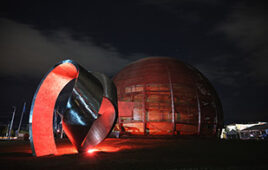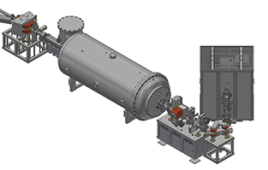
Brookhaven scientists are pictured at NSLS-II beamline 8-ID, where they used ultra-bright x-ray light to ‘see’ the chemical complexity of a new catalytic material. Pictured from left to right are Klaus Attenkofer, Dong Su, Sooyeon Hwang, and Eli Stavitski. Credit: Brookhaven National Laboratory
Using costly and extremely rare metals to convert carbon dioxide to carbon monoxide may soon be a thing of the past.
A team from the U.S. Department of Energy’s Brookhaven National Laboratory has identified a new nickel electrocatalyst that can help convert CO₂ to CO, a highly energetic molecule that can be used to make fuel and other useful chemicals.
“There are many ways to use CO,” Eli Stavitski, a scientist at Brookhaven and an author on the paper, said in a statement. “You can react it with water to produce energy-rich hydrogen gas, or with hydrogen to produce useful chemicals, such as hydrocarbons or alcohols.
“If there were a sustainable, cost-efficient route to transform CO2 to CO, it would benefit society greatly,” he added.
Scientists have long sought a method to convert CO₂ to CO. However, traditional electrocatyalysts cannot effectively initiate the reaction because a competing reaction of water splitting—also called the hydrogen evolution reaction (HER)—takes precedence over the CO₂ conversion reaction.
Certain noble metals, including gold and platinum, avoid HER and convert CO₂ to CO, but are both extremely rare and expensive. This forced the researchers to replace the noble metal nanoparticles with single atoms of nickel, which catalyzed the CO₂ conversion with a maximal of 97 percent efficiency.
“Nickel metal, in bulk, has rarely been selected as a promising candidate for converting CO2 to CO,” Haotian Wang, a Rowland Fellow at Harvard University and the corresponding author on the paper, said in a statement. “One reason is that it performs HER very well, and brings down the CO2 reduction selectivity dramatically.
“Another reason is because its surface can be easily poisoned by CO molecules if any are produced,” he said.
In addition to the unique energetic properties of single atoms, the CO2 conversation reaction was facilitated by the interaction of the nickel atoms with a surrounding sheet of graphene, enabling the team to tune the catalyst and suppress HER.
The researchers used scanning transmission electron microscopy (STEM) by scanning an electron probe over the sample and visualize discrete nickel atoms on the graphene.
“Single atoms are usually unstable and tend to aggregate on the support,” Dong Su, also a CFN scientist and a co-author on the paper, said in a statement. “However, we found the individual nickel atoms were distributed uniformly, which accounted for the excellent performance of the conversion reaction.”
The researchers analyzed the chemical complexity of the material using a beamline 8-ID—an ultra-bright X-ray light that allowed the team to see a detailed view of the material’s inner structure.
“Photons, or particles of light, interact with the electrons in the nickel atoms to do two things,” Stavitski said. “They send the electrons to higher energy states and, by mapping those energy states, we can understand the electronic configuration and the chemical state of the material.
“As we increase the energy of the photons, they kick the electrons off the atoms and interact with the neighboring elements.”
The study was published in Energy & Environmental Science.




